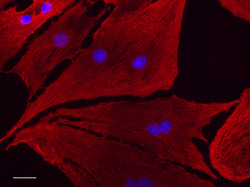
Northwestern Medicine scientists have discovered the role iron plays in weakening a person’s heart following treatment with the common chemotherapy drug doxorubicin (DOX).
Hossein Ardehali, MD, PhD, associate professor in Medicine-Cardiology and Molecular Pharmacology and Biological Chemistry, found that cardiomyopathy, a prevalent side effect of DOX, is dependent on the accumulation of iron inside the mitochondria of cells.
“When we started these experiments we thought the cardiomyopathy-doxorubicin link may have something to do with the mitochondria rather than the notion that the iron buildup was occurring in muscle cells as a whole,” said Dr. Ardehali, a member of the Feinberg Cardiovascular Research Institute and the Robert H. Lurie Comprehensive Cancer Center. “Our investigations showed that to be true.”
The findings were recently published in the Journal of Clinical Investigation.
Used in chemotherapy, doxorubicin is credited as a “wonder drug” for greatly reducing pediatric cancer deaths throughout the 1990s. Although heart damage remains the most serious side effect, DOX is commonly used in the treatment of a wide range of cancers, including those of the breasts, lungs and ovaries.
“It really has revolutionized the field of oncology, but it has this serious drawback,” Dr. Ardehali said. “As an attending I can recall asking why young women treated for breast cancer were developing cardiomyopathy. The response at that time was, ‘We don’t know.’ ”
The lab took multiple approaches to finding that answer.
Using an animal model, scientists were able to demonstrate a reversal of doxorubicin-induced cardiomyopathy by removing iron from the mitochondria. The lab also demonstrated that a drug used to treat DOX-induced heart weakness works by reducing mitochondrial iron, something that hadn’t previously been shown.
“In this publication, we were able to produce several different lines of evidence: genetic, pharmacological and patient samples to prove this uptick in mitochondrial iron was one of the culprits,” Dr. Ardehali said. “Doxorubicin has been around for several decades, but no one had been able to determine why it caused cardiomyopathy.”
Combined with a recent paper suggesting a specific protein also plays a role in heart damage, Dr. Ardehali believes scientists have now identified two independent pathways involved.
Moving forward, the lab will work to produce a drug that would specifically reduce mitochondrial iron to treat doxorubicin-induced cardiomyopathy. Dr. Ardehali’s group has already identified a number of potential compounds and is working in collaboration with the Center for Molecular Innovation and Drug Discovery (CMIDD) to begin preclinical trials.
“One of the advantages of being a physician-scientist is that I see the clinical aspects of medicine and also have the ability to look at the molecular mechanisms causing disease,” Dr. Ardehali said. “Scientists have made great advancements but there remain many diseases where we still can’t explain what is happening. This is no longer one of them.”
The project was funded by National Institutes of Health grants HL107448, HL087149, HL104181, and HL108795.






